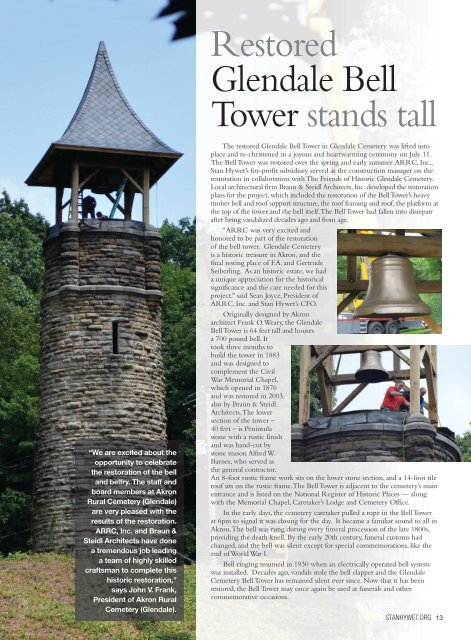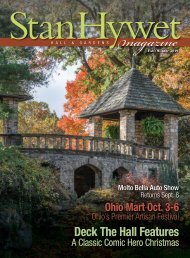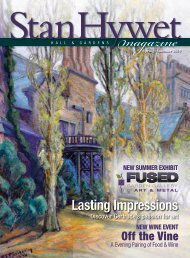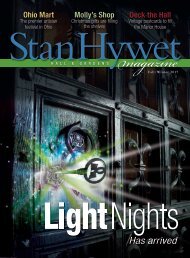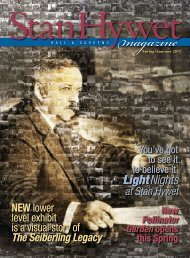StanHywetFallMag
You also want an ePaper? Increase the reach of your titles
YUMPU automatically turns print PDFs into web optimized ePapers that Google loves.
Restored<br />
Glendale Bell<br />
Tower stands tall<br />
“We are excited about the<br />
opportunity to celebrate<br />
the restoration of the bell<br />
and belfry. The staff and<br />
board members at Akron<br />
Rural Cemetery (Glendale)<br />
are very pleased with the<br />
results of the restoration.<br />
ARRC, Inc. and Braun &<br />
Steidl Architects have done<br />
a tremendous job leading<br />
a team of highly skilled<br />
craftsman to complete this<br />
historic restoration,”<br />
says John V. Frank,<br />
President of Akron Rural<br />
Cemetery (Glendale).<br />
The restored Glendale Bell Tower in Glendale Cemetery was lifted into<br />
place and re-christened in a joyous and heartwarming ceremony on July 11.<br />
The Bell Tower was restored over the spring and early summer. ARRC, Inc.,<br />
Stan Hywet’s for-profit subsidiary served as the construction manager on the<br />
restoration in collaboration with The Friends of Historic Glendale Cemetery.<br />
Local architectural firm Braun & Steidl Architects, Inc. developed the restoration<br />
plans for the project, which included the restoration of the Bell Tower’s heavy<br />
timber bell and roof support structure, the roof framing and roof, the platform at<br />
the top of the tower and the bell itself. The Bell Tower had fallen into disrepair<br />
after being vandalized decades ago and from age.<br />
“ARRC was very excited and<br />
honored to be part of the restoration<br />
of the bell tower. Glendale Cemetery<br />
is a historic treasure in Akron, and the<br />
final resting place of F.A. and Gertrude<br />
Seiberling. As an historic estate, we had<br />
a unique appreciation for the historical<br />
significance and the care needed for this<br />
project.” said Sean Joyce, President of<br />
ARRC, Inc. and Stan Hywet’s CFO.<br />
Originally designed by Akron<br />
architect Frank O. Weary, the Glendale<br />
Bell Tower is 64 feet tall and houses<br />
a 700 pound bell. It<br />
took three months to<br />
build the tower in 1883<br />
and was designed to<br />
complement the Civil<br />
War Memorial Chapel,<br />
which opened in 1876<br />
and was restored in 2003,<br />
also by Braun & Steidl<br />
Architects. The lower<br />
section of the tower –<br />
40 feet – is Peninsula<br />
stone with a rustic finish<br />
and was hand-cut by<br />
stone mason Alfred W.<br />
Barnes, who served as<br />
the general contractor.<br />
An 8-foot rustic frame work sits on the lower stone section, and a 14-foot tile<br />
roof sits on the rustic frame. The Bell Tower is adjacent to the cemetery’s main<br />
entrance and is listed on the National Register of Historic Places — along<br />
with the Memorial Chapel, Caretaker’s Lodge and Cemetery Office.<br />
In the early days, the cemetery caretaker pulled a rope in the Bell Tower<br />
at 6pm to signal it was closing for the day. It became a familiar sound to all in<br />
Akron. The bell was rung during every funeral procession of the late 1800s,<br />
providing the death knell. By the early 20th century, funeral customs had<br />
changed, and the bell was silent except for special commemorations, like the<br />
end of World War I.<br />
Bell ringing resumed in 1930 when an electrically operated bell system<br />
was installed. Decades ago, vandals stole the bell clapper and the Glendale<br />
Cemetery Bell Tower has remained silent ever since. Now that it has been<br />
restored, the Bell Tower may once again be used at funerals and other<br />
commemorative occasions.<br />
STANHYWET.ORG 13


